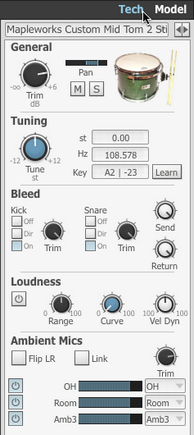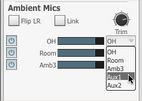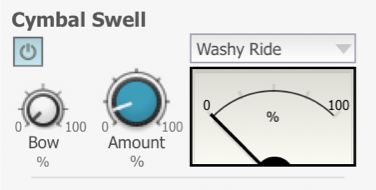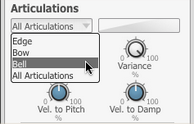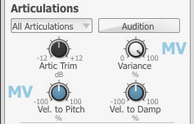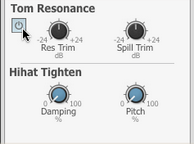|
The Drum Editor contains a comprehensive set of tools to adjust the sound and response of the Drum in the currently selected slot. It is designed to allow you to tweak each part of the kit just like you would in a real-world drum recording environment. The Drum Editor features 2 pages, each displayed with the Tech and Model tab buttons on the main BFD3 navigation bar. |
Click the Tech or Model tab buttons to make the panel visible if it is currently hidden. To hide the panel again, click the currently active tab button.
•The Tech page deals with 'drum-technician' type tasks such as tuning, control over bleed and ambient mics.
•The Model page is oriented towards BFD3's drum modelling functions such as tom resonance, cymbal swells, damping and choking response. It also features advanced control over individual Drum articulations.
Tech page
|
General section Trim The Trim control is an overall volume control for the Drum. Adjusting it affects the level of all the Drum's mic channels equally. It can be considered as a 'pre' volume control - it sets the level of the Drum at the start of the signal path before any routing and mixing features are applied. Pan The Drum's Pan control is identical to that on its channel in the mixer. It sets the position in the stereo field of the Drum's Direct mics only. It does not affect the Drum's Ambient mic channels. The Ambient mics section features the Flip LR button to invert the stereo image of the Drum's stereo Ambient mic channels - this can be useful if you need to pan a Drum to the other side of the stereo field. Mute / Solo These buttons mute and solo all mic channels for the Drum. Drum image ALT-click this image to preview the Drum's main articulation.
Tuning section Tune / st The Tune function increases (clockwise from centre position) or decreases (anti-clockwise from centre position) the pitch of the Drum. It is possible to tune Drums up to an octave away from its original pitch. The amount of tuning is shown in the st display. Click this display to enter a tuning amount in semitones. |
While tuning cymbals has no obvious real-world equivalent, it is still very useful to do so in the virtual domain. With snares, the sidestick can optionally remain unaffected if the Disable sidestick tuning option is enabled in the BFD3 Engine Preferences.
Hz / Key / Learn
These displays and controls are available only for Tom slots. When a Tom is loaded, BFD3 automatically calculates its fundamental pitch, which is is shown in the Hz display and its equivalent MIDI note is shown in the Key display. Click the Learn button and play a MIDI key - the Tune setting for the Tom is set to a pitch equivalent to that of the played key, within an octave of the tom's original pitch. The key that is played is shown in the Key display, with the new new pitch displayed in the Hz and st displays.
Bleed section
The Bleed controls allow you to adjust the level and routing of a Drum's bleed and spill signals. Bleed signals in BFD3 represent the sound of other Drums captured by the Kick and Snare mics, while spill is simulated bleed in the Tom mics.
Bleed destination
The Bleed destination buttons allow control over the routing of the recorded bleed from the Drum within the Kick and Snare mics. 3 routings are possible:
On
The Drum's bleed is routed as normal to the first Kick and Snare slots' mixer channels.
Direct
The Drum's bleed is routed to its primary direct mic channel. Therefore, there would be no bleed from the Drum in the Kick and Snare mic channels.
Off
The Drum's bleed is disabled completely and not heard in the mix at all.
Trim
This control adjusts the level of the recorded Kick/Snare bleed signals.
Bleed Send
The Bleed Send control adjusts the overall level of all bleed output from the Drum - this includes recorded bleed (the sound of the Drum recorded in the Kick/Snare mics) and simulated spill - simulated bleed signals of the following types:
•Kick in the Tom mics
•Snare in the Tom mics
•Toms in other Tom mics
Bleed Return
The Bleed Return control sets the input level of the mix of all bleed signals routed to the Drum's direct mic channels. This includes the following:
•Any recorded bleed or simulated spill signals from other Drums
•The recorded bleed signal from the Drum itself if it is routed to its primary direct mic channel (using the Direct Bleed destination setting described above) - this is the only possible signal for hihat/cymbal/percussion slots.
Adjusting bleed levels globally
You can change overall bleed levels by using the Kick, Snare and Other Master bleed controls on the mixer's Master channel, visible while the Tweaks channel mode is active (click the Tweaks button above the mixer).
Loudness section
The Loudness controls relate to the dynamics of the Drum - its playing intensity and the resulting level and timbre.
Power
Activating this button enables the Loudness section controls. With the Power button deactivated, none of the controls in the Loudness section have any effect on the Drum.
Vel Dyn (Velocity Dynamics)
The Velocity Dynamics control shifts the velocity range of incoming events (from MIDI notes or from the Groove engine) - in effect, making the 'drummer' play the Drum with more or less intensity.
Curve
The Curve control allows you to alter the amplitude of the Drum in response to the incoming velocity of MIDI or Groove trigger events.
With the Curve control at 0, there is an exact 1:1 mapping of incoming velocity to the natural recorded amplitude of the corresponding velocity layer.
As the control is increased, the level of the resulting audio from the event is increased from its natural recording level between the minimum and maximum velocity values. The greatest increase in gain occurs at the middle of the velocity range.
Range (Dynamic Range)
The Range control effectively extends the range of the dynamics curve by using automatic amplitude adjustment of the range of samples for the velocity layers. Increasing the control creates a larger difference in amplitude between the quietest and loudest layers for each articulation.
Ambient Mics section
The Ambient Mics section's controls allow manipulation of the various Ambient mic channels for a Drum, providing many creative opportunities that would simply not be possible in a real-world drum recording.
Flip LR
Most Ambient mic channels, such as Overhead/Room/Amb3 channles, are stereo and the sound of the Drum is 'fixed' within it - it cannot be panned within the stereo field, unlike the Drum's direct mics. This is an inherent drawback of true stereo ambience.
The Flip LR button inverts the stereo image of any stereo ambient mic channels for the Drum which can be useful if panning a Drum's direct mics to the other side of the stereo field.
In addition the Width controls for Ambient mic sub-channels (when the mixer is set to Tweaks channel mode by clicking the Tweaks button) can be used to manipulate their stereo properties.
Trim
The Ambient Mics Trim control provides an overall level control for all ambient mic channels for the Drum. It can be considered as a simple 'wet/dry' control for the Drum.
Any Ambient Mics Trim adjustments are applied in addition to the individual Level controls described below.
Link
Enabling the Ambient Mics Link button results in the Drum's main mixer channel level fader being linked to its Ambient Mics Trim parameter. This means that adjusting the kit-piece's mixer level results in a corresponding adjustment being applied to the Ambience Trim meaning that you can adjust the level of the Drum in the direct and ambient mics using a single fader.
Power / Level controls
Each Ambient mic channel type contained within the Drum features its own horizontal Level fader in this section, allowing you to independently set the level of the Drum within each set of ambient mics.
Each channel can be disabled entirely by deactivating its Power button.
|
Routing selector By default, all Ambient mic signals for each Drum is routed to the corresponding Ambience mic channels in the BFD3 mixer. However, the Routing selector drop-down menus override these default routings - each channel can be routed to a discrete Aux channel for further processing or subsequent routing outside BFD3.
|
Model (Modelling) page
|
Damping section The Damping controls allows you to decrease the decay of the Drum, simulating the effect of a blanket or pillow inside a kick drum or placing objects which absorb vibrations onto a snare or tom head. Amount Use the Amount control to set the amount of damping required. Freq The Freq control represents a crossover frequency. Below this frequency, the decay of the Drum's ambient mic channels is shortened according to the damping amount. Above the frequency, less damping is required. This results in a more natural ambience sound when using the damping functions. To damp the entire frequency range within the ambient mics, increase the Freq control to its maximum setting. Amb Ratio The Amb Ratio control allows you to adjust the amount of damping in the Ambient channels. With the control at the default maximum setting, less damping occurs in the Ambient channels than on the direct channels. With the control at the minimum setting, the same amount of damping is applied in the direct and Ambient channels. Envelope section /////// The Envelope controls allow you to decrease the decay of the Drum, simulating the effect of a blanket or pillow inside a kick drum or placing objects which absorb vibrations onto a snare or tom head. Attack Use the Boost control to set the amount of damping required. Sustain The Sustain control represents a crossover frequency. Below this frequency, the decay of the Drum's ambient mic channels is shortened according to the damping amount. Above the frequency, less damping is required. This results in a more natural ambience sound when using the damping functions. To damp the entire frequency range within the ambient mics, increase the Freq control to its maximum setting. Choke Response section The Choke Response section provides control over the choking behaviour of a Drum - in other words, how a preceding event for the Drum decays when a new event is triggered. Power button The Power button must be activated for the settings in this section to be applied to the current Drum. If the button is deactivated, the default choke response settings specified in the Preferences are used. Base/Range All Drum types have a default choking behaviour which is defined in the BFD3 preferences using a set of Base/Range values. The Base and Range controls in the Drum Editor allow custom choking responses for individual Drums. See the Engine Preferences section for more details on setting Base/Range values. |
Drag (Snare only)
This parameter allows the adjustment of the additional Drag Choke fade time for Snares, and is not available for other Drum types.
Choke Group
The Choke Group function allows you to create choking behaviour between Drums - setting 2 Drums to the same Choke Group means that they choke each other.
Cymbal Swell section
|
The controls in this section are only available when a Cymbal is the currently selected Drum. When activated with the Power button, Cymbal articulations played in rapid succession are shaped to simulate their real-world behaviour. Swell algorithms Several Swell algorithms are provided, selectable via the drop-down menu - each provides different swell characteristics. |
Bow
The Bow control dampens the cymbal.
Amount
The Amount control adjusts the intensity of the cymbal swell emulation.
The meter displays a real-time representation of the energy within the cymbal when the Swell function is active.
Articulations section
|
These controls are provided for tweaking the response of individual Drum articulations although they can be applied for all articulations if you wish. Articulation selector Select the articulation to adjust using the Articulation selector drop-down menu - select All articulations in order to affect all articulations in the Drum. |
|
Multiple values If any articulations feature individual settings for any of the controls in the Articulations section, a Multiple Value indicator is shown beside it when All Articulations is currently selected for editing. Note that adjusting any control with All Articulations selected results in overwriting the individual settings for any articulations. |
|
Audition strip The Audition strip plays a preview the selected articulation when clicked. The velocity of the audition depends on where the strip is clicked – the lowest velocity layer is at the left side of the strip and the highest later is at the right. With All articulations specified in the selector, a preview of the Drum's main articulation is played.
|
Artic Trim
The Artic Trim control adjusts the level of articulations between -inf and +12dB.
One of the most common examples for using this control would be to change the level of closed hihat articulations in relation to open ones. With the Hihat slot selected, select the Closed Tip articulation and adjust the Artic Trim control, repeating the process for the Closed Shank articulation.
The default setting for this control is 0 dB, meaning that all articulations are played at their natural recorded levels.
Vel to Pitch
The Vel to Pitch control allows the tuning of each articulation to vary depending on incoming trigger event velocity. Uses of this control range from extreme creative effects to very subtle changes which can give some extra character to the sound of the kit.
Settings range from -100% to 100%. Positive values result in increasing pitch with higher velocities, while negative values result in decreasing pitch with higher velocities.
Vel to Damp
The Vel to Damp control allows the amount of damping applied to the articulation to be varied according to the velocity of incoming trigger events. It effectively allows you to control the decay of articulations with velocity and can offer very interesting approaches to dynamics and space within your drum tracks.
Any changes in the damping applied to each articulation as a result of this parameter are applied relative to the Drum's overall Damping Amount setting.
Settings range from -100% to 100%. Positive values result in increased damping with higher velocities, while negative values result in reduced damping with higher velocities.
Variance (Anti-machinegun variation)
This control adjusts the maximum amount of loudness or tonal humanization that is possible for the articulation.
BFD3 features 2 controls to adjust the global amount of 'Anti-MachineGun' humanization, located in the Dashboard - click the Dashboard button in the LCD display in the top-centre of the interface. The Loud (Loudness humanize) control adjusts the amount of volume randomization applied across the kit, while the Tone (Tone humanize) adjusts the amount of randomization between velocity layers, leading to tonal variation due to the Drum being struck at a different intensity. The maximum amount of variation for each Drum in the kit is dictated using the Drum Editor's Variance control. The AMG button in the Dashboard must be activated to enable these functions.
These functions serve to make drum parts sound less 'robotic' or 'machinegun-like' by adding natural-sounding dynamic and tonal variations that are inherent in a human drummer's performance.
Setting the Variance control to zero can be useful for avoiding humanization of certain parts of the kit.
Tom Resonance
The Tom Resonance functions create the sympathetic resonance generated by Toms when other Drums are played. These functions are available only for the Kick, Snare and Tom slots.
|
Power This button enables or disables the resonance function for the Drum. When it is active, the Drum triggers the tom resonance algorithm in the Tom slots. Res Trim This control adjusts the level of the resonance generated by the Drum in the Tom slots. Spill Trim This control adjusts the level of the Drum's bleed or spill signals (if they exist) in the Tom slots. |
Hihat tighten (Hihat slot only)
This function allows you to adjust the closed Hihat sound to sound tighter and more snappy. It achieves a similar result to the regular Damping functions at the top of the Modelling page, except that only the closed Hihat articulations (Closed Tip and Closed Shank) are affected.
The Damping control adjusts the amount of tightening that is applied to closed tip articulations. The Pitch control adjusts the amount of subtle pitch increase that occurs as the hihat is tightened.
The Hihat Tighten function varies within the closed zone when using variable hihat control so that the amount specified with the controls is applied at the maximum closed pedal position (when the pedal MIDI CC# value is 127).

